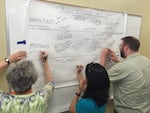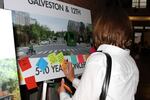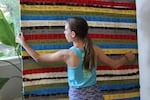
Livability conference participants make a list of challenges in east Bend. Many said it's difficult to walk to shopping, parks or restaurants in Bend, and that east-west bike transit corridors are lacking.
Amanda Peacher / OPB
Last Friday, Bend residents Phillip Price and Ann Cook contemplated several computer-generated visualizations of Galveston Street in Bend, one of several images showing how Bend might develop over the next 10 years.
Cook didn't like the visualization of Galveston’s five- to 10-year future. Right now, the street has several pubs and one-story local businesses. The visualization showed new four- or five-story brick buildings.
“That starts to make me feel uncomfortable,” Cook said. “Because it looks quite different, and it looks a lot more urbanized with the taller buildings.”
Price said the area is already a gathering place in the city: “It’s one of the more dynamic areas. I wouldn’t change a neighborhood that’s working.”
But both Price and Cook also said they recognize that Bend needs more density in the city center, which currently features only one- or two-story buildings.

Ann Cook adds her comments to a visualization of the future for one commercial corridor in Bend. As Bend grows, some parts of the city will need to densify.
Amanda Peacher / OPB
The exercise was part of a three-day event called the Bend Livability Project and aimed at planning for Bend’s future. For the past few years, Bend has been one of the fastest-growing metropolitan areas in the nation.
And that growth isn’t expected to slow. Today, there are about 87,000 residents in Bend.
By the year 2030, researchers at Portland State University forecast it at 130,000 people — a 40 percent increase.
So how can Bend accommodate all those new people without losing the charm and feel that made it a popular destination in the first place?
Improving An Oft-Overlooked Part Of Bend
On a Saturday afternoon, 30 people crowded into a classroom to talk about the east side of Bend, a more residential and commercial part of town. The area has fewer neighborhood amenities, compared to Bend's historic west side.
The moderator, an energetic civil engineer named Stephanie Serpico, kicked off the conversation by placing sheets of butcher paper around the room. She asked people to write down what they consider missing from Bend's east side neighborhoods.
Kathy Austin used a Sharpie to add her thoughts: "True walkable paths along the canal."
Austin said she can't safely get to shops or cafes walking from her house.
Others wanted public spaces, bikeways, small businesses and art. One person wrote that they'd love to see a food cart pod like one on Bend's west side.
The elephant in the room, and in every room during the conference, is that all this projected growth means a lot more development. Bend leaders are proposing an urban growth boundary expansion that will add about 2,000 acres to the city limits. But the plan calls for Bend not only to expand out, but also up.
Related: Portland, Bend Among Top Cities For Home Price Increases Last Year
"Whether we like it or not, that proposal is going to require us to densify," said Erin Foote Morgan, who heads up Bend 2030, the nonprofit leading the livability project. "We're talking about urbanization in a big way in Bend."
Foote Morgan said that if Bend is to remain livable, it also needs to be affordable.
"You look at housing," Foote Morgan said. "We do not have enough workforce housing to accommodate the development of our economy. Transportation? We do not have the kind of system that allows us to do much else but drive in our city."
Right now, Bend's downtown features mostly two-story buildings. The thought of seven story construction downtown, or apartment complexes in single-family home neighborhoods, is hard for some to accept.
During the brainstorm session about east Bend, people in the room got fired up. They made an action list: they want to figure out how to get more bike lanes, find space for a community garden and help with efforts to fund public transit. A few people even gave each other high fives.
By the end of the session, they'd even given themselves a name: the Eastside Coalition.
"We're going to try and get together to get a plan together," Serpico told the group, passing around a sign-up sheet. "To do something. To take action."
For Morgan, who organized the event, this is exactly the kind of action she was hoping for from conference participants.
"I think a lot of people feel that it's somebody else's role to lead," she said. "My hope is that we create a whole new wave of people who start paying attention to civic issues and who understand that their ideas are just as good as anybody else's."
